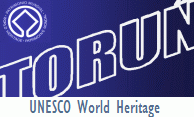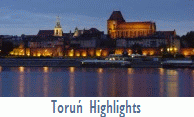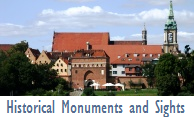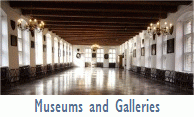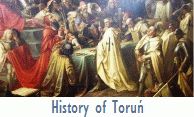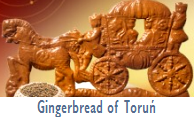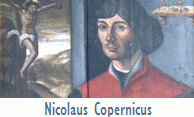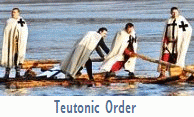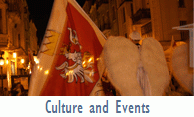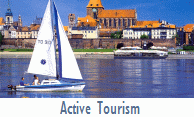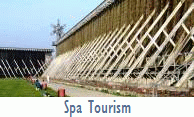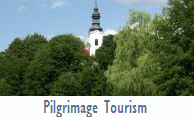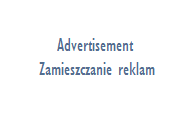|
Toruń 1793-1920 - The town of border
Exposition at the Eskens' House Museum
 On 18th January 1920 Toruń celebrated the comeback to Poland after the period of partitions. Apart from the science session and accompanying events, a permanent exhibition devoted to the history of Toruń from the end of the 18th century to 1920 was opened in the museum. Paradoxically, if it had not been for the fact that as a result of the Second Partition Toruń became the part of the German Kingdom of Prussia in 1793, its comeback to Poland in 1920 would not have taken place and we would not celebrate on 18th January. It is undoubtedly oversimplification, since the history of Toruń of that period was filled with, often stormy and complex, events. The alterations of borderline alone, and the fact that the town belonged to different states as a result, might confuse even experienced historians. It was twice that Toruń was in Kingdom of Prussia - from 1793 to 1806 and from 1815 to 1871, when German empire came into existence (so called 2nd Reich). There the town became automatically a strategic centre of great significance due to its location at the border wit the Russian empire. This state continued till the end of the First World War. Previously, from 1807 to 1815, it was one of the main towns of Ksiestwo Warszawskie (the Duchy of Warsaw). It is also worth mentioning that the First Partition moved the Prussian border several kilometers away from Toruń. The issue has been illustrated with the extensive collection of maps, and the plans of the town, which shape was strongly influenced by location (the construction of fortifications). On 18th January 1920 Toruń celebrated the comeback to Poland after the period of partitions. Apart from the science session and accompanying events, a permanent exhibition devoted to the history of Toruń from the end of the 18th century to 1920 was opened in the museum. Paradoxically, if it had not been for the fact that as a result of the Second Partition Toruń became the part of the German Kingdom of Prussia in 1793, its comeback to Poland in 1920 would not have taken place and we would not celebrate on 18th January. It is undoubtedly oversimplification, since the history of Toruń of that period was filled with, often stormy and complex, events. The alterations of borderline alone, and the fact that the town belonged to different states as a result, might confuse even experienced historians. It was twice that Toruń was in Kingdom of Prussia - from 1793 to 1806 and from 1815 to 1871, when German empire came into existence (so called 2nd Reich). There the town became automatically a strategic centre of great significance due to its location at the border wit the Russian empire. This state continued till the end of the First World War. Previously, from 1807 to 1815, it was one of the main towns of Ksiestwo Warszawskie (the Duchy of Warsaw). It is also worth mentioning that the First Partition moved the Prussian border several kilometers away from Toruń. The issue has been illustrated with the extensive collection of maps, and the plans of the town, which shape was strongly influenced by location (the construction of fortifications).  Toruń was also the borderland of the nations inhabiting the area - the Germans and the Poles. There was also Jewish community an increasing steadily during the 19th century. Various confessions existed beside each other. The same, West frontage of The Old Market Square, was the place where evangelists prayed in the contemporary Church of Holy Spirit, Catholics gathered in the Church of Our Lady, and in Szczytna street nearby Jews had their prayers in a synagogue. It was inevitable that members of different nationalities mingled - not only in the streets, but also in schools, guilds, societies and Prussian or German army. They made deals, often were partners. The Germans and Jews were most often employers, belonging to the most well-off classes; however, the Poles were members of these too. The religious divisions were not as clear as it seems. A lot of the Germans were not protestants and went to church together with the Poles. They were loyal members of their parishes and frequently strongly opposed the germanisation of their neighbours and fellow believers. There was also the Polish evangelic group in Toruń (it was deprived of its church of St George in the times of Księstwo Warszawskie (the Duchy of Warsaw) which was pulled down during the construction of fortifications). The mixed marriages were not rare. Although a lot of Poles lost their national identity, plenty others regained it because of the growth of German nationalistic tendencies. It can be said that the Polish spirit was reborn in Toruń at the end of the 19th century. It is worth mentioning that there were Germans who were polonised. The good example is Otto Steinborn, who not only had a lot of Polish friends, both during his studies in Chełmno and after he had settled down in Toruń, and a Polish wife, Helena born Kawczyńska, but also was interested in the Polish language, culture and history, and became a political, social and patriotic activist. In 1920 he welcomed Polish army to Toruń and as the first Polish mayor of the town took the power over from the Germans, and later on was a senator. It is worth remembering that after 1815, especially between 1871 and 1914, Toruń was a developing commercial and industrial centre, as well as growing urban area. It resulted mainly from the fact that the town was the place where various kinds of troops were deployed, the building of a railway, and a modern fortress. The significance of towns closeness to the Russian border cannot be forgotten either. Toruń was also the borderland of the nations inhabiting the area - the Germans and the Poles. There was also Jewish community an increasing steadily during the 19th century. Various confessions existed beside each other. The same, West frontage of The Old Market Square, was the place where evangelists prayed in the contemporary Church of Holy Spirit, Catholics gathered in the Church of Our Lady, and in Szczytna street nearby Jews had their prayers in a synagogue. It was inevitable that members of different nationalities mingled - not only in the streets, but also in schools, guilds, societies and Prussian or German army. They made deals, often were partners. The Germans and Jews were most often employers, belonging to the most well-off classes; however, the Poles were members of these too. The religious divisions were not as clear as it seems. A lot of the Germans were not protestants and went to church together with the Poles. They were loyal members of their parishes and frequently strongly opposed the germanisation of their neighbours and fellow believers. There was also the Polish evangelic group in Toruń (it was deprived of its church of St George in the times of Księstwo Warszawskie (the Duchy of Warsaw) which was pulled down during the construction of fortifications). The mixed marriages were not rare. Although a lot of Poles lost their national identity, plenty others regained it because of the growth of German nationalistic tendencies. It can be said that the Polish spirit was reborn in Toruń at the end of the 19th century. It is worth mentioning that there were Germans who were polonised. The good example is Otto Steinborn, who not only had a lot of Polish friends, both during his studies in Chełmno and after he had settled down in Toruń, and a Polish wife, Helena born Kawczyńska, but also was interested in the Polish language, culture and history, and became a political, social and patriotic activist. In 1920 he welcomed Polish army to Toruń and as the first Polish mayor of the town took the power over from the Germans, and later on was a senator. It is worth remembering that after 1815, especially between 1871 and 1914, Toruń was a developing commercial and industrial centre, as well as growing urban area. It resulted mainly from the fact that the town was the place where various kinds of troops were deployed, the building of a railway, and a modern fortress. The significance of towns closeness to the Russian border cannot be forgotten either.  The exhibits which the exposition consists of, and which number reaches a thousand, were grouped in chronological order divided into chapters that were characteristic and significant for Toruń: The exhibits which the exposition consists of, and which number reaches a thousand, were grouped in chronological order divided into chapters that were characteristic and significant for Toruń: 1) Toruń in Prussia 1793-1807,
2) Toruń in the Duchy of Warsaw 1807-1815,
3) Toruń in Prussia and German Empire 1815-1920,
4) the comeback of Toruń to The Republic of Poland in 1920.
Apart from the above there are some topic groups, e.g. Gymnasium and Education, Polish and German science societies: Coppernicus Verein für Wissenschaft und Kunst and The Science Society in Toruń, Churches, Jewish Community, Memorabilia of craft and economoc life, Associations (Rifle Club, Masons' Lodge, Reading Society, The Society of Embellishing the Town, Gymnasts Society "Sokół" , Singers Society "Lutnia") There is a great variety of objects, representing e.g. paintings, engravings, faleristics, numismatics, archival materials, photography, cartography, archaeology, craft, and weaponry. The paintings that deserve special attention are the ones of Toruń mayors and townsmen. Engravings present mainly the views of the town. Activity of Polish and German science societies is illustrated by the collection of medals, coins and archaeological objects, and additionally by documents and publications. A large part of the exhibition is filled with archival materials and photos preserving the look of the town and the events that took place - they are the necessary complementation of historic exhibitions. The craft is represented by guild memorabilia for instance wilkom, beer mugs, diplomas and opulently decorated banners. The objects of craft are also represented in large number in other parts of the exhibition e.g. liturgical objects such as epergne, wine glasses, christening bowls, and candlesticks, frequently branded by Toruń goldsmiths. There is also the weapons of Rifle Club made by Toruń gunsmith. The authorities and local administration are reminded of by not only documents but also the unique collection of stamps of offices and institutions from the Prussian times as well as the period of the Duchy of Warsaw. From that period there are also two genuine signboards of Podprefektura Powiatu Toruńskiego (Semi-Prefecture of Toruń County) and Sąd Pokoju Wydziału Spornego Drugiego Powiatu i Miasta Torunia (Court) with inscriptions in French and the crest of the Duchy of Warsaw. The exhibition begins with blue and white, the colours of Toruń, board which is the background for the wooden crest of the town fro the end of the 18th century from the former Pharmacy of Town Council. The majority of objects belong to different divisions of the Museum. They were completed with the objects from the State Archives in Toruń, Copernicus Library in Toruń, the Learned Society in Toruń, The Museum of Art in Łódź, and the private collection of Tadeusz Zakrzewski from Toruń.
|
| All rights reserved Toruń 2005-2009 | About us | CenterMedia |



